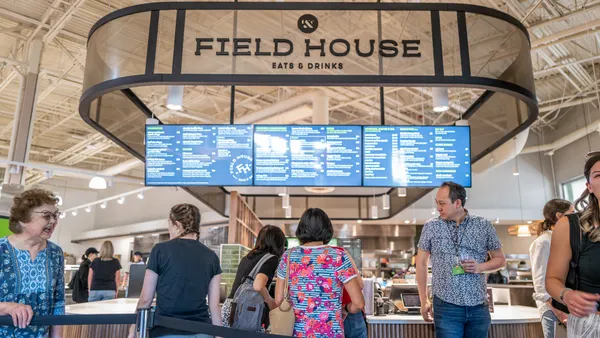Dive Brief:
- Seafood and meat led perimeter growth in the second quarter with sales up 31.7% and 29.4% from 2019, respectively, while produce saw a sales uptick of 15.1%, a new report by the United Fresh Produce Association has found.
- Notable Q2 trends in the fresh food segment included a 9.3% year-over-year sales uptick in fruit sales and 21% growth in vegetable sales, with prepackaged salads, tomatoes and potatoes the highest selling fresh produce.
- Meanwhile, organic produce dollar sales reached $2.2 billion last quarter, up 14.8% from the same period in 2019 and accounting for 11.3% of all produce dollars. The report, which also recorded the widely reported popularity growth of e-commerce, was based on scan and consumer behavior data provided by Nielsen.
Dive Insight:
Beyond the stage of "pandemic pantries," data from Nielsen on fresh food grocery sales indicates that consumers are still opting to take fewer trips to the supermarket for fresh products, despite easing restrictions, translating to higher average dollars per buyer.
Products that are more challenging for consumers or perceived as intimidating to prepare saw growth, as home-cooking continues to be par for the course in the public health crisis. A report by marketing agency Acosta published last month recorded a majority of consumers eating at home more frequently since the onset of the coronavirus pandemic, though 40% of shoppers cited difficulties coming up with varied meal ideas. For grocers, new or unconventional fresh options may be a route to keeping shoppers excited and interested in home cooking as restaurants reopen and expand their menus.
While meat, seafood, and fresh fruit and vegetables all witnessed dollar growth compared to Q2 of 2019, value-added produce sales, particularly in the fruit meal prep segment, had a difficult summer. Shopper spending on fruits and vegetables that underwent processes like cutting or mixing before being put out for sale yielded mixed results, as overall sales in this category declined 4.7%.
Despite being in recent years one of the primary growth drivers for the fresh food segment, sales of produce that is traditionally consumed in a group setting, such as mixed fruit and fruit platters, plummeted this summer. Sales also declined in the deli and bakery segments, which were hit badly by the pandemic as grocers have struggled to adapt them for consumers shopping in bulk or online.
The steady sales growth for fresh produce, meat and seafood indicates that consumers are more readily buying these items online, a shift from 2018 when Mintel data recorded just one in 10 Americans willing to do so. This is particularly the case for products with a longer shelf life, such as pre-packaged salads, which the Fresh at Retail report noted had growth momentum in both in-store and e-commerce sales.










